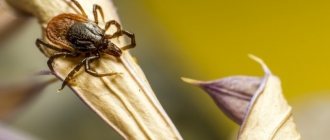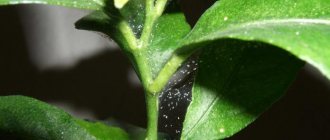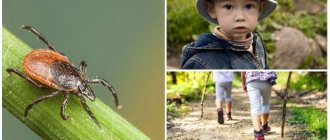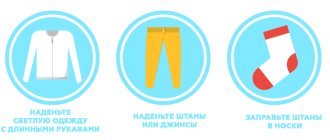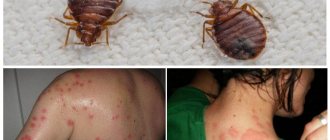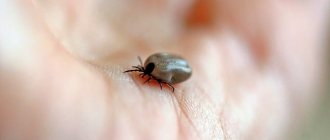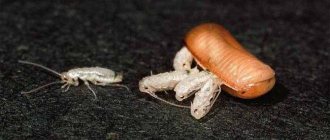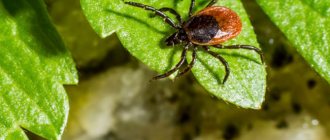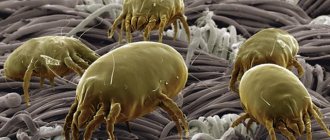As soon as winter ends and warming begins, authorities begin to implement policies to alert the population to the danger. What is the reason for such activity of the authorities? This is explained by the fact that it is at this time that ticks appear in the forests, which pose a mortal threat to human health.
As carriers of serious diseases, they can cause significant damage to human health. After all, signs of infection do not appear immediately, but after some time. And therefore, any delay can turn into a tragedy. To protect yourself, a person needs to clearly understand when there is danger.
When tick season begins and when it ends, this is information that all citizens should have in order to be able to protect themselves. It is quite problematic to accurately determine the beginning of the season. This is due to different weather conditions. Scientists remind that as soon as a stable warm temperature is established, the parasites wake up. In other words, as soon as the snow melts and the temperature rises to 15–20 degrees, the chances of encountering this parasite in the forest will increase.
When do ticks appear?
Already in April - May, patients with tick bites come to the hospital. Because it is during this period that they appear on the soil surface. Somewhere from mid-April, when the weather is warm and the sun warms the ground well, thawed patches appear. And at this time the ticks wake up.
Due to the fact that these insects are constantly in search of food, the number of victims increases sharply. Please note that in the future their activity does not depend on the weather. Even if the summer is quite cool, dangerous insects will continue their “hunt”. Therefore, care must be taken even in rainy weather.
When does tick season end?
We are talking about the summer period, so when going on vacation, a person wants to be sure that he will be completely safe. This issue becomes especially relevant in August. When the heat subsides, it begins to seem that it is more difficult to meet a tick in the forest or in the park.
This is due to the number of ticks, because it is rapidly decreasing. And therefore, in the middle of summer, people who have been bitten practically do not turn to doctors for help. Such a decrease in numbers is associated with the death of insects. The cause of death is the lack of reserve nutrients in their body.
But this does not mean at all that in August or September you can not worry and relax calmly. Experts assure that parasites can be found in parks and forests even in October. Provided the weather is favorable. That is why it is generally accepted that the tick season ends with the first noticeable cold weather.
Feasibility of vaccination
In Siberia, the issue of protection from dangerous pests is acute. Resist mass disease with a vaccine. People who plan to visit Siberia in the next six months are subject to mandatory vaccination. In this way you can protect yourself from encephalitis. 3 vaccinations are provided with an interval of 1 month. Vaccinations are carried out in Moscow and other cities in public and private clinics.
There is no vaccine against borreliosis and some other diseases; they protect themselves with repellents to repel parasites and thick clothing. In the forest you should dress so that there are no exposed skin areas. When you get home, you should throw everything in the wash.
Peak parasite activity
According to scientists, ticks are most active from the beginning of April to the end of June. During this period they are looking for food, so the frequency of attacks on animals and people increases. It is especially dangerous during such a period to be not only in the forest, but also in pastures. After all, first of all, warm-blooded animals such as cows, sheep, and goats suffer from them.
The period when ticks are most active largely depends on the following factors:
- Satiety of parasites - at the moment when ticks are satiated, they begin to be more concerned about reproduction than nutrition;
- The number of small mammals, arachnids - ticks are food not only for birds. Spiders and amphibians also feed on them. And if the number of natural enemies of parasites is large enough, then their population is significantly reduced. However, if there is regular treatment using toxic chemicals that kills spiders and other amphibians, mite numbers increase;
- Human activity - parasites try to stay closer to the food supply. Therefore, it is quite expected that their numbers will be quite impressive in places where livestock are commonly grazed.
As you can see, a variety of factors can provoke a peak in activity. And therefore it is quite difficult to predict it accurately.
Life cycle features
Nymphs, fertilized females, overwinter. The former continue the development cycle, the latter complete it - they lay eggs, giving life to a new generation. In spring, the number of eggs laid is in the thousands. The life cycle of a tick lasts 2 years, during which time the parasite changes 3 hosts.
After their birth, the larvae begin to look for their first host. They become wild animals, rodents, birds. They drink blood and disappear after a few days. In well-warmed soil they molt and turn into a nymph. This happens either at the end of summer or autumn. In the first case, the pest looks for a host again, in the second, it hibernates.
The second host for nymphs are wild animals, domestic animals, artiodactyls, rodents, and parasites also attack people. Having drunk blood, the nymph falls to the ground again and turns into an imago. Further development continues in the spring of next year. Young females and males find prey, drink blood, and achieve sexual activity. They begin to lay eggs.
Life cycle of a tick
Period of activity in the Leningrad region
As we have already found out, the period of appearance of parasites is difficult to determine precisely. But another interesting fact is that not in all areas the situation with bites is critical. There is a special map on which endemic zones for tick-borne encephalitis are clearly marked. The Leningrad region is also an endemic zone.
Tick habitat map
Therefore, predicting when ticks appear in the Leningrad region is a little easier. This is due to a certain static nature. In such areas they appear regularly and at approximately the same time. Due to specific weather conditions, the period of their activity is not so long. Ticks appear in early April and remain dangerous until mid-May.
It is noteworthy that scientists predict a worsening of the situation in this region. According to statistics, every year the number of people who contact the clinic with a complaint of a parasite bite increases (despite the fact that the Leningrad region is in the yellow zone on the map, tick activity increases every year). Although in other endemic zones its decline is observed. In the Leningrad region, according to experts, the situation is almost critical and requires greater caution from people.
Methods of protection
During the active period, ticks perfectly detect the approach of warm-blooded animals within 10 - 15 m.
The limbs of insects have hooks with which they catch the person or animal that touches them and dig into the body.
Arms and legs must be covered
To protect yourself, a person needs to choose appropriate clothing for a walk in the forest: a shirt with a tight-fitting collar and cuffs and trousers, which are best tucked into high socks. It is preferable to wear boots on your feet, and some kind of headdress or hood on your head. The inconvenience of such equipment in warm weather is compensated by safety in the event of an encounter with a parasite.
During your walk, you should carefully inspect yourself and your companions for ticks.
Particular attention should be paid to the ears, armpits, groin and other hairy parts of the body. Ticks that have not yet attached themselves may end up in the folds of the fabric, so it is best to remove all clothing before entering the room and wash it thoroughly
Animals are also carefully examined; if an attached tick is detected, it must be immediately carefully removed by treating the bite site. For an overview of the anti-encephalitis suit, watch this video:
One of the most effective methods of protection is vaccination against tick-borne encephalitis based on a killed virus. Vaccinations should be done from the end of October to April in 4 stages. This measure is especially relevant in places of increased tick activity and for those whose work involves frequent visits to forests and parks.
Period of activity in the Moscow region
The period of ticks in Moscow begins at the end of April, beginning of May. The first to suffer from them are small rodents, wild hares, and dogs. It is during this period that breeders complain that they find ticks on the fur of their four-legged pets. If we talk about people, the first victims are summer residents and those who like to celebrate the May holidays in nature.
But since ticks love dry, moderately warm weather, at the height of summer their activity declines. In June and July they practically do not bother people. However, if the weather is favorable for them, the situation may change. But if the summer is really hot, then insects resume activity only at the end of August.
Precautions when visiting dangerous areas and places
You can pick up a tick anywhere, even in Moscow, St. Petersburg, Kyiv, Minsk or any other city. But most often they occur:
- in a forested area;
- in a forested area;
- on a summer cottage.
For forest walks and outdoor recreation, choose closed clothing; the collar of your outerwear should fit close to your neck, and it is advisable to tuck in your T-shirt. Sleeves and trouser legs should be long. It is better to wear rubber shoes, preferably high boots. Cover your head with a headscarf or cap. If the clothes are light, then it will not be difficult for you to see a tick crawling on it.
For stops and parking in the forest, choose dry pine meadows without tall thickets. Don’t sit on the ground, much less lie down on the grass. Before and after spending the night, be sure to inspect your entire body.
From time to time, inspect yourself and your loved ones for the presence of bloodsuckers. This issue should not be taken lightly. If you find a tick that has not yet attached itself, remove it from yourself. If it has stuck, then the faster you remove it, the less the risk of contracting a serious disease.
Forest clothing must be stored separately from regular clothing so that ticks do not transfer to it. Upon arrival from the forest, inspect your clothes, shake them out in a place away from populated areas and put them in a bag and tie it tightly. Another good way to protect your clothes from ticks is to treat them with an acaricide before and after a walk in the forest.
Use products that repel or kill ticks. The drugs can be purchased at pharmacies and hardware stores. Before purchasing and using, be sure to read the instructions.
Remember! There are three main types of tick sprays:
Repellent
– repels ticks, can be applied to exposed skin. They last for about 2-5 hours, then disappear.
Acaricidal
– kill ticks, applied to clothing, not applied to skin. The effect lasts up to several days.
Acaricidal-repellent
– at the same time they repel and, in case of contact of the parasite with the substance, paralyze it.
In what weather are insects most dangerous?
Quite often, experts hear from people the question of how the weather affects the activity of parasites. Indeed, temperature conditions can largely affect the activity of ticks. The most favorable range is considered to be from 15 to 20 degrees Celsius. They do not tolerate heat very well, so on a dry, sunny day the chances of becoming a victim of this parasite are negligible.
They are also affected by air humidity. And, unfortunately, many people forget about this. Moreover, there is an opinion that rain helps to reduce their activity. Of course, walking through the forest during rain, you are completely safe. But in general, moisture is a favorable factor for them. It is noteworthy that insects prefer cloudy weather. After all, the air is saturated with humidity. This is why walking through a forest, park or pasture in cloudy weather is not a good idea. Even if it's summer, like August. It is important to remember that ticks can attack even in September or October.
From what has been written above, we can conclude that determining the exact time when ticks awaken is not an easy task. This is true. Moreover, in certain areas they are activated much earlier. For example, residents of the Leningrad region are forced to put up with the fact that these parasites begin to attack them in early spring - early April. But in other areas they may appear in May or even early June.
That is why quite often people ask specialists another question: what temperature is favorable for ticks to awaken? After all, knowing this, it is much easier to predict exactly when to start fearing for your health and take precautions.
When answering the question at what temperature ticks are activated, it is necessary to mention that awakening occurs at a fairly low temperature - only 1-3 degrees Celsius. Why does no one come to the clinic with complaints during this period? This is explained by the fact that at this temperature people dress quite warmly. And therefore the risk of being attacked by a parasite is practically zero. Consequently, the awakening of ticks itself remains largely unnoticed by people.
Fighting methods
You can repel them with cologne with a strong smell, essential oils of citronella, lavender, and cloves. They use sprays and aerosols - Gardex, Reftamid Antiklesch, Raptor, Raid, Taiga, Off, Moskitol. Spray clothes thoroughly; some products can be applied directly to the skin.
To rid your land of parasites and ensure safe outdoor recreation, they use smoke bombs - Quiet Evening, Whirlwind, Fomorian. Use solutions for spraying grass and trees based on insectoacaricides. You can poison with the drug Cifox, Sinuzan, Executioner, Medilis-Ziper, Forsyth.
Ticks are not poisoned en masse, as this increases the chances of death of natural enemies - birds, animals, insects. This explains the fact why there are a lot of ticks. Initially, after using chemicals, pests disappear, but along with them, natural enemies. Over time, the population of pests increases, but there are no “exterminators” of them. A situation arises when people say, before there were no ticks, now there are a lot of them.
Pests can become active at the end of March and end their activity in November. Therefore, you should always remember about safety, but you should not be afraid of panic. Not all ticks are contagious; if you consult a specialist in a timely manner, the risk of the disease is reduced or the disease proceeds without complications. You should protect yourself in advance with clothing, anti-tick medications, and get vaccinated when visiting dangerous territories or areas.
Cloth
When going on vacation, first of all, it is important to ensure that you have the proper clothing. And it doesn’t matter where exactly you are going, to the forest, to the nearest park or to the country - ticks can be found absolutely anywhere where there is at least some vegetation. And to prevent the bloodsucker from sucking on, it is necessary to cover the entire body. Moreover, close it correctly, and this can be done if you know the structural features of the tick, due to which it can only crawl upward.
- For the upper body - something with long sleeves. This could be a shirt, jacket, raglan, etc. In this case, it is desirable that the collar covers the neck.
- For the lower body, trousers are a must. It is better to refrain from wearing shorts.
- Pants should be tucked into socks, and the top of clothing should be tucked into the bottom. For added protection, you can tighten the belt around your waist.
- It is important that all clothing is made of dense materials. As for its tones, light ones are preferable, since such ticks are quite easy to notice.
On a note! Surprisingly, the thinnest nylon tights can stop ticks. Although this is far from the most suitable item of clothing for outdoor recreation, although on the other hand they can be worn under trousers!
On sale today you can find special suits called anti-encephalitis, popularly known as encephalitis. They are made of durable, dense fabrics and equipped with drawstrings that provide additional protection against ticks. But if you don’t like this suit, then you don’t have to buy it. It’s quite possible to limit yourself to your everyday clothes, but you just need to tuck them all in!
How to protect yourself while hiking
When hiking at rest stops or while walking, you should not sit down or lie down to rest in the grass; it is better to choose places where the soil is bare or tear out all the grass within a radius of several meters. A barrier in the form of a cleared area will create good protection - ticks do not leave areas covered with grass.
It is better to choose places for overnight and rest away from the paths in dry, bright places (there are more ticks in the damp corners of the forest). The camp site should be cleared of grass, leaves, dead wood and sprayed with acaricidal agents (special preparations for ticks).
For hiking in the forest and mountains, you must wear closed shoes and trousers, jackets or long-sleeve T-shirts. Clothing should fit snugly to the body at the wrists and ankles. A hat or hood is required. There are also special anti-encephalitis suits that you can use. Exposed areas of the body should be treated with repellent ointments or sprays.
While hiking in the forest, you must periodically inspect your body and clothing. When a tick lands on a person, it begins to look for areas of thin, delicate skin and often attaches itself in the area of the abdomen, groin, scalp, throat, armpits, so these parts of the body need to be examined more carefully - the tick is small, sometimes it is difficult to notice it the first time. Upon returning from the forest or park, clothes should be carefully inspected, and it is better not to enter the house in them, but to leave them outside in the sun for several hours.
Pet owners may be bitten by a tick carried into the home on their fur. Therefore, dogs and cats need to be treated with special protective sprays or drops, and carefully examined after walks.
Basic safety rules. How to avoid meeting them
The best tick repellent for people: how to choose
There are several groups of means to protect humans from ticks. They differ in the principle of influence.
Repellents – have a repellent effect, prevent insects from landing on the skin, including mosquitoes, mosquitoes, etc. It is possible to apply to human skin, treat (spray) clothing. As a rule, these are drugs based on the active substances (a.i.) diethyltoluamide (deta), or methylbenzamide, less often alphacypermethrin, cypermethrin. They belong to protection classes III and IV, the effect is due to an odor that irritates mites - it was previously assumed that parasites temporarily lose their sense of smell.
The duration of action of repellents depends on the concentration: for example, a product with 30% active ingredient content. retains the effect for up to 5-6 hours, about 100% - up to 12 hours or more.
Acaricidal drugs have a nerve-paralytic effect. They belong to the group of neurotoxins-peretroids. The drugs affect the central nervous system by blocking nerve impulses. When paralyzed ticks come into contact with treated areas of human clothing, they fall off and die.
Compared to repellents, they are more toxic. Contact of human skin with the products is highly undesirable.
Among the drugs used to protect against ticks, the active ingredient is an insecto-acaricide (active ingredient alphacypermethrin (alfametrin), cypermethrin, alpha-cypermethrin, permethrin).
According to reviews from tourists, foresters, fishermen and other people, the best anti-tick remedy for humans in terms of price-quality ratio is based on the insectoacaricides cypermethrin, alphacypermethrin.
These products for protecting people from ticks are used both for treating skin and clothing (the least toxic and less effective), as well as for treating exclusively clothing, shoes, equipment, items of uniform and equipment, mosquito nets, etc.
The optimal concentration for a pronounced effect of a product based on cypermethrin is about 0.02%.
Insecticidal-repellent agents have a combined effect: they repel ticks from human skin and have an acaricidal effect. They protect people not only from all types of ticks, but also from blood-sucking ones, united under the general name “midge complex” - many types of midges, biting midges, etc.
Products for humans that combine the two effects are based on two components: most often diethyltoluamide and alphamethrin.
Tick vaccination
If you spend a lot of time outdoors, then using various creams and sprays is not what you need. It will cost a pretty penny and you will have to spray it all the time. In this case, it is better to get vaccinated against tick-borne encephalitis. But before you do it, you need to find out what it is.
The vaccine protects you from the disease, but not from the bite. Those. you will also be attacked by parasites. The vaccination can be done at any age. The only exception is children under one year old. The vaccine is safe, but each body reacts individually, and side effects are possible.
There is little point in vaccinating those who visit nature once or twice during the summer. The vaccine is given to those who work in areas of high parasite activity, to children before going to camps, and to outdoor enthusiasts. 95% of vaccinated people do not get sick when bitten. But there are still 5% who can, despite the vaccine, contract the disease. But it will occur in an extremely mild form. And therein lies the danger. You can attribute a slight malaise to completely different diseases. Therefore, even if you are vaccinated after a tick bite, it is still worth getting your blood tested. The vaccination is effective even with multiple bites from infected individuals.
The vaccination is given in medical institutions. The vaccination is done not once, but three times at intervals. The first is done in the fall, the second a month or two later, and the third a year later. Afterwards they repeat it once every three years.
After the full course, you can donate blood for analysis to detect antibodies in the blood. This way you can be sure that the vaccination works. There are also contraindications, so you should consult your doctor before vaccination.
When should you take out tick insurance?
It is worth purchasing insurance coverage against tick bites in advance, before the start of the season.
If a tick bite occurs, insurance provides a free set of measures, such as prevention, laboratory tests, treatment, and the purchase of medications. Like other types of voluntary health insurance, this type of insurance helps to provide high-quality medical care in a clinic verified by the insurance company and protect not only your health, but also your budget.
Sources
htps://kleshei-net.ru/sezon-kleshei/ htps://TaraKlop.ru/kleshchi/sezon-aktivnosti-kleshhey/ htps://kleshun.ru/sezon-kleshhej/ htps://combat-dez. ru/kogda-poiavliautsia-kleshi-i-kogda-zakanchivaetsia-sezon-ih-naibolshei-aktivnosti/ htps://usatym.net/kleshhi/karta-rasprostraneniya-kleshhevogo-encefalita-v-2021-godu/ htps:// animashka.info/kleshchi/karta-kleshchej.html htps://Dezoff.ru/kleshhej/kleshchi-v-2020/ htps://misterklop.ru/klesshi/sezon-aktivnosti-kleshhej-v-rossii-kogda-nachalsya -i-kogda-zakonchitsya htps://chistiy-dom35.ru/kleshchi/kogda-aktivny.html htps://dezbox.ru/dezinsekciya/odezhda-dlya-zashhity-ot-kleshhej-vybiraem-luchshij-variant/ htp ://www.medicus.ru/wellness/patient/rekomendacii-po-zaschite-ot-ukusov-kleschej-166295.phtml htps://stopklopu.com/sezon-klesej-2020-periody-aktivnosti-klesej-po- mesacam/ htps://beetlestop.ru/meryi-zashhityi-ot-kleshhey/ htps://usatym.net/kleshhi/est-li-v-krymu-encefalitnye-kleshhi-kak-izbezhat-ukusov-posledstviya/ htps: //parazitdoma.ru/sovety/sredstva-ot-kleschey-dlya-lyudey-kak-vybrat-i-kakie-schitayutsya-luchshimi htps://kleshei-net.ru/zaschita-ot-kleschey/ htps://kaplife .ru/life-insurance/stop-klesch/sezon-kleshchey/
When ticks appear in spring - the beginning and end of the active season, how to protect yourself
How parasites behave at night
As you know, some species of animals, reptiles, and arachnids are more active at certain times of the day. For example, some species of spiders prefer to go hunting in the dark. But does this rule apply to ticks? Perhaps at night or early in the morning a person can feel relatively safe?
Studies that have been carried out repeatedly have shown that ticks have no connection to the time of day. They can be dangerous both at night and during the day. However, it is necessary to make a small clarification. On hot summer days, when the temperature reaches 30 degrees, the activity of parasites decreases. They prefer to stay in their hiding places and not attack victims.
But as soon as night falls, bringing with it coolness, they leave their shelters. And that is why the illusion is created that periods of their activity may depend on the time of day. But in reality this is not the case. The only thing that can affect the activity of ticks is weather conditions. If they are favorable, the ticks will begin searching for food.
Danger to humans
Diseases from ticks
Pests feed on blood and are carriers of dangerous diseases. After a tick bite, a blister, a red spot, itching, irritation, and an allergic reaction appear. In the absence of the virus, the effects of activity disappear on their own without special treatment within a week. Once the virus enters the bloodstream, the development of a terrible disease begins; the incubation period lasts from several days to 2 months.
Carry:
- theileriosis;
- piroplasmosis in dogs;
- Lyme disease;
- erpichiosis;
- hematozoonosis;
- tularemia for cats, dogs;
- tick paralysis;
- fever;
- encephalitis.
The most dangerous are ixodid ticks. The virus remains in the blood and is transmitted to the younger generation. Ticks themselves do not get sick, they transmit the virus to humans, and become infected by the bite of an infected wild animal. They wake up early in the spring, are active throughout the warm season, and may disappear in November. Unfavorable weather conditions can reduce the activity of this type of parasite.
